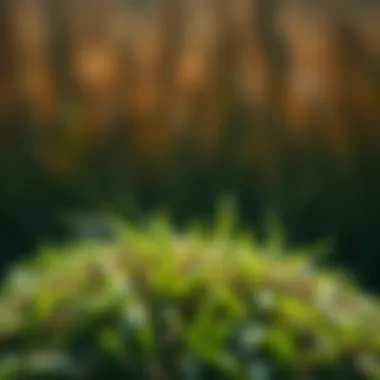Locating Quality Grass Sod: A Comprehensive Guide


Intro
Acquiring quality grass sod is no small feat; it's a cornerstone to creating a vibrant, healthy lawn or garden. For many, knowing where to source this vital component can be just as important as understanding how to install and maintain it.
Many may not realize that the type of grass sod you choose can dramatically affect not just how your lawn looks, but also how it performs in your specific environment. From local climate conditions to soil types, various factors play a role in your choice of sod. Gardeners and agricultural enthusiasts alike should invest time understanding these specifics for optimal results.
Beyond the basics of selection and installation, there’s also a fine balance to strike between quality and cost. Some sod vendors may offer cheaper options but, as they say, you often get what you pay for. In this guide, we will explore everything from the types of grass available to vendor selection and the best practices for successful installation and maintenance. Prepare to discover the intricate steps towards cultivating lush, thriving green spaces.
Understanding Grass Sod
Grass sod serves as the foundation of many outdoor spaces, transforming barren ground into lush, vibrant lawns that enhance both aesthetics and utility. It’s crucial to grasp the ins and outs of what grass sod is and how it operates in your garden or landscape. Knowing the intricacies can help prevent costly mistakes and ensure the longevity of your green spaces.
Definition and Importance
Grass sod is essentially a rolled-up section of grass and its underlying soil. It's a ready-to-laid solution that provides immediate coverage, making it the go-to choice for homeowners looking to establish a lawn without the long wait that comes with seeding. The importance of understanding grass sod lies not just in its immediate aesthetic appeal but also in its role in soil health and environmental balance. Choosing high-quality sod can mitigate challenges such as soil erosion, promote better drainage, and offer a habitat for local wildlife.
Types of Grass Sod
When it comes to grass sod, not all types are created equal. Different varieties cater to distinct needs based on climate, shade, and intended use. Here's a look into the primary categories:
Cool-Season Grasses
Cool-season grasses thrive in areas with cold winters and moderate summers. These grasses develop most actively in spring and fall, providing an excellent choice for those living in temperate climates. A key characteristic of cool-season grasses is their rich green color, which remains vibrant longer into the cooler months. Perennial Ryegrass is a popular pick for quick establishment, while Kentucky Bluegrass provides a lush, dense lawn that is highly attractive. However, their performance can suffer during extreme heat, requiring significant watering and care during the summer.
Warm-Season Grasses
In contrast, warm-season grasses flourish in areas with hot summers and warm winters. They take off in the heat and can go dormant during chillier months. Bermudagrass is a prime example of warm-season grasses, appreciated for its durability and ability to withstand heavy foot traffic, making it perfect for sports fields and recreational areas. Yet, it can require more maintenance and is less effective in colder climates, limiting its use.
Shade-Tolerant Varieties
Shade-tolerant varieties cater specially to lawns that do not receive full sunlight. These sods are uniquely formulated to thrive under the canopy of trees or buildings. Species like Fine Fescue and certain types of Zoysiagrass stand out for their ability to maintain integrity in low-light conditions. While they provide a more manageable solution for shady spots, they may present challenges with water retention and overall growth when not treated properly.
Benefits of Using Sod
Choosing sod, rather than seed, presents a variety of advantages worth considering.
Instant Lawn Coverage
One of the most appealing aspects of sod is its capacity to create an instant lawn. Unlike seeding, which can take weeks to germinate and establish, sod offers immediate visual impact. A well-prepared sod installation can transform your landscape within hours.
Soil Erosion Prevention
By providing immediate coverage, sod acts as a natural barrier against soil erosion. This is vital in areas subjected to heavy rains or on slopes where loose soil can wash away easily. The network of roots in turf establishes rapidly and helps secure the soil in place, preventing runoff.
Environmental Attractiveness
Quality sod contributes positively to the environment. It helps maintain air quality, regulates temperature, and provides a habitat for various insects and wildlife. A healthy lawn also acts as a natural filter for rain runoff, improving the overall quality of water entering drainage systems.
In summary, a solid understanding of grass sod—its definitions, types, and benefits—creates a foundation for successful lawn care and outdoor landscaping. An informed choice in selecting sod can ensure a flourishing lawn that heightens the beauty of your environment.
Where to Buy Grass Sod
Finding the right source for grass sod is a crucial step to ensure a lush, green lawn. When it comes to establishing your outdoor space, the point of purchase can greatly influence the overall health and appearance of your lawn. It's important to consider factors such as local climate, sod type, and intended lawn use to make informed decisions about where to buy.
Purchasing sod from reputable sources not only enhances your lawn's aesthetics but also promotes sustainable practices. The various options available offer unique advantages and potential drawbacks. In this section, we will dive into four primary sources: local garden centers and nurseries, online vendors, wholesale suppliers, and landscaping companies. Each option comes with its own characteristics and benefits that can fit different consumer needs.
Local Garden Centers and Nurseries
Local garden centers and nurseries are often the best first stop for anyone seeking high-quality grass sod. These establishments usually provide a more personalized shopping experience and can share local expertise regarding grass types suited to your area. Visiting your local nursery allows you to see the sod in person, checking for freshness and quality before any purchase is made.
Many times, the staff at these centers have in-depth knowledge about local growing conditions and can give tailored advice for your specific lawn requirements. Additionally, fresh sod is often delivered from local farms, meaning you get a top-notch product that’s already acclimatized to the environment.
However, be mindful that these places may charge a bit more than larger retail chains due to their smaller scale and premium offerings. To get the most out of your visit, ask specific questions about the sod varieties available and any ongoing maintenance that may be required.
Online Vendors
The rise of e-Commerce has brought a wave of online vendors specializing in grass sod, offering easy access to a wide selection from the comfort of your home. Shopping for sod online offers convenience and can even introduce you to types that may not be available locally.
Reputable Websites


When selecting an online vendor, looking for reputable websites is essential. Sites like SodSolutions.com or GotSod.com are known for quality products. These websites often have specific sections where you can filter sod by grass types and regional suitability, making your life easier.
A key characteristic of reputable websites is strong customer service — many offer live chat options or informative customer support. This accessibility can help answer any lingering questions about the sod or delivery details before making a commitment. Keep in mind the potential downside of purchasing online: without inspecting the sod personally you can't gauge its freshness. In rare cases, that could lead to dissatisfaction, so always check the vendor's return policy to protect your investment.
Evaluating Online Reviews
Evaluating online reviews is a game changer when selecting an online vendor. Genuine reviews from previous customers provide insights that are invaluable. By sifting through feedback, you can gauge the quality of the sod and service offered.
Look out for reviews mentioning the sod's health and vibrancy upon arrival. Websites such as Yelp or Trustpilot can give you a broader understanding of a vendor's reputation. However, be cautious of reviews that seem too positive or negative without details; they're often not reliable. Customer reviews can shed light on the vendor’s shipping practices, ensuring you choose a reputable site that values customer care.
Wholesale Suppliers
Wholesale suppliers generally cater to larger orders and professionals but can be a good source for homeowners looking for a bulk purchase. These suppliers often sell at a discounted rate compared to retail stores, making it a cost-effective option.
It's wise to note, however, that buying in bulk means you may need to have some means of transportation, as these suppliers might not deliver smaller quantities to residential areas. You can find detailed information on wholesale suppliers from agriculture-focused websites or by contacting local farms known for their sod production.
Landscaping Companies
Landscaping companies can serve as convenient intermediaries for your sod buying needs. Many offer sod installation services along with the purchase, saving you time and effort. Established landscaping companies often have strong relationships with sod producers and can source quality grass that meets your specifications.
Although this option may come at a premium, the benefits can outweigh the costs, especially if you prefer a hands-off approach when it comes to installation. They handle all logistics, which can reduce the stress of DIY projects, especially if you're new to gardening or landscaping.
Overall, each purchasing channel provides unique attributes that can benefit your grass sod acquisition process. Whether you prefer visiting a local nursery or browsing online, your choice can significantly impact the success of your lawn. Take your time evaluating these options to ensure you make the best purchase for a thriving and sustainable green space.
Evaluating Quality of Grass Sod
Assessing grass sod’s quality is crucial for anyone looking to lay down a lush, green carpet in their yard. When it comes to sod, not all is created equal. A thorough evaluation before purchase can save time, money, and the heartache that comes with a bare, patchy lawn. Making an informed choice enables a smoother establishment period and sets the stage for a thriving, sustainable lawn.
Visual Inspection Criteria
Color Uniformity
Color uniformity speaks volumes about the health of the sod. When a sod piece displays a consistent green color throughout, it often indicates that it has been grown under optimal conditions. This rich color of grass not only gives an aesthetically pleasing look but also suggests that the sod is healthy and vibrant.
Key Characteristics: Maintaining a strong, uniform green can help make the lawn carpet appear well cared-for. A bright green hue reflects that it is adequately nourished and appropriately watered. However, spotting inconsistencies—like patches of yellow or brown—can foretell problems.
Advantages and Disadvantages: A sod with a strong color uniformity can integrate better into your lawn’s overall design while signaling to the purchaser that they’re getting a high-quality product. However, natural variations might create a rainbow effect, which could be hard to manage should one piece of sod vary starkly in color from another.
Density and Texture
Density and texture are the elements that dictate the touching experience of your lawn. A sod that is densely packed with blades not only stands up to foot traffic but also promotes better moisture retention. It provides a cushion underfoot, making for a comfortable walking surface.
Key Characteristics: The thickness of grass blades and the density of growth are crucial characteristics to consider. A robust sod will display a tight-knit structure of grass blades that can resist wear and tear, making it a popular choice for active families and pets alike.
Advantages and Disadvantages: While a denser sod might require more water due to its compact nature, it also leads to a higher resilience against pest invasions. However, it might impose a challenge with mowing for beginners if the texture is significantly uneven.
Soil Health Assessment
Root System Quality
The vitality of the root system cannot be understated when evaluating sod. A robust root system is the foundation upon which healthy grass thrives. It ensures that the sod has a good grasp on the soil beneath it, supporting its longevity and resilience to environmental stresses.
Key Characteristics: An adequate root system generally appears white and is rich in fibrous elements. A quality root system digs deeply into the soil, promoting proper nutrient absorption. Roots that extend beyond a few inches indicate the sod was cultivated in a supportive environment.
Advantages and Disadvantages: Having a strong root system enhances the sod’s survival rates during and post-installation. However, if roots are short or appear dark, it indicates potential issues, which risk the potential of a healthy lawn.
Soil Composition and pH
Understanding soil composition and pH levels is another pivotal factor when evaluating grass sod quality. Different grass types thrive under various soil conditions. The right pH level can influence nutrient availability and sod performance.
Key Characteristics: Quality sod often grows in soil that's rich in organic matter. The ideal pH is typically in the 6.0 to 7.0 range for most grasses, allowing them to access essential nutrients effectively.
Advantages and Disadvantages: Good soil composition fosters a beneficial environment for growth, enhancing sod durability and health. Nevertheless, sod with poor soil profiles might be a surprise to the buyer later, as ongoing amendments may be necessary to maintain a lush appearance.
Age and Freshness of Sod
The age and freshness of sod are critical factors that directly influence its establishment and subsequent performance. Freshly harvested sod is more likely to root effectively once laid down. Fresh sod tends to have a vibrant color, an underlined dampness, and a cohesive root system indicating its readiness for growth.
In contrast, older sod that has been cut and stored for too long may lose its vigor. Importance lies in ensuring that you choose sod that’s been harvested within a day or two prior to laying it down. This heightens the chances your lawn will flourish beautifully. A thorough evaluation in this aspect can lead to not just a faster establishing lawn but a more resilient one as well.


Factors to Consider Before Purchase
When thinking about buying grass sod, a few key factors come into play that can make or break your lawn dreams. Understanding these elements not only leads to a successful sod installation but also ensures that your grass thrives in the long run. In this section, we’ll discuss the compatibility of sod with your local climate, the intended use of your lawn, and the necessary maintenance requirements.
Climate Compatibility
Before selecting sod, knowing your climate is crucial. Grass types suitable for your environment will ensure that you get the best performance from your lawn. Different grasses thrive under varying temperature and moisture conditions. For example, cool-season grasses are perfect for areas with cold winters and moderate summers. On the flip side, warm-season grasses flourish in regions where summers are long and hot.
It's also essential to consider humidity levels, average rainfall, and the general weather patterns in your area. An unsuitable choice based on climate can lead to poor growth and increased susceptibility to pests and diseases. As a savvy buyer, be sure to select species of sod that align with your local forecast.
Intended Use of Lawn
When planning to purchase sod, think about how you intend to use the lawn. Each application comes with its unique considerations.
Residential Areas
For residential areas, homeowners often desire a lush, vibrant lawn that enhances curb appeal. The right sod can contribute positively to your home’s aesthetic, adding value and a welcoming atmosphere. Popular choices for residential setups include Kentucky Bluegrass or Fescue, known for their soft texture and rich colors.
In addition, residential lawns require sod with good wear resistance, as they often host family activities, pets, or gatherings. Choosing the right grass that can handle foot traffic while looking great can make all the difference.
"A well-kept lawn says a lot about its owner."
Commercial Properties
When it comes to commercial properties, sod choices might lean differently. Grass in these areas often faces a range of challenges from heavy foot traffic to maintenance routines optimized for aesthetics rather than play. For this reason, many property owners favor sod varieties like Bermuda grass, which is durable and stands up well to both activity and varying weather.
In a commercial setting, maintaining an attractive landscape can enhance client perception and provide an inviting atmosphere for visitors. However, these lawns may also demand more intensive maintenance, so consider how much time and effort you can realistically allocate for care.
Maintenance Requirements
Lastly, another pivotal factor is what it takes to maintain the sod after installation. Different grass types come with their own sets of requirements. This includes watering schedules, fertilization, and mowing practices. While some grasses may only need minimal upkeep, others could require regular feedings or specific watering techniques to stay healthy.
It's smart to choose sod that aligns with your lifestyle and willingness to maintain it. Investing in a low-maintenance grass type might save you time and effort in the long run.
Best Practices for Sod Installation
Sod installation is not merely about laying down sheets of grass; it requires thoughtful preparation and execution to ensure a lush, vibrant lawn. Proper installation practices can make the difference between a thriving yard and a patchy disaster. The importance of adhering to best practices when dealing with sod cannot be overstated. Following these guidelines ensures that the sod is given the best chance to establish healthy growth, ultimately rewarding you with a stunning green space.
Preparing the Soil
Before you even think about rolling out the sod, the first step is preparing the soil properly. This phase is critical for a successful installation, as it lays the foundation for the future health of your lawn.
- Clearing the Area: Remove any existing grass, weeds, or debris. The site should be clear and clean to allow for effective sod establishment.
- Testing Soil pH: A simple soil test can help determine nutrient levels and pH. Most grasses thrive in a slightly acidic to neutral soil range (pH 6.0 to 7.0). If your soil falls outside this range, amend it as needed.
- Tilling the Soil: Loosening the soil with a tiller can improve aeration and drainage. Ideally, the soil should be tilled to a depth of around 4 to 6 inches. This process encourages root penetration and enhances nutrient absorption.
- Adding Amendments: Based on the soil test results, you might need to mix in organic matter or fertilizers to enrich the soil. Compost is a wonderful option as it improves structure and fertility.
Laying the Sod
Now that your soil has been prepped, it's time to lay the sod. Properly positioning the sod is essential not only for aesthetics but also for root establishment.
- Stagger the Joints: When laying down rolls or squares of sod, make sure to stagger the seams in a brick-like pattern. This method prevents straight lines that could lead to weak spots.
- Fit the Pieces Together: Avoid gaps by fitting sod pieces tightly together. Gaps can dry out and cause uneven growth. If the edges don’t fit perfectly, cut them to size using a sharp knife.
- Leveling Off: After laying the sod, use a roller to apply firm pressure, ensuring good contact between the sod and soil. This practice helps eliminate air pockets which can hinder root growth.
Initial Watering Guidelines
Watering is one of the most critical aspects of sod installation. The way you water your fresh sod can set the stage for either failure or success.
- Water Deeply and Frequently: Right after installation, water the sod thoroughly. It's crucial to wet the sod and the soil beneath it. Aim for about 1-2 inches of water to ensure the roots begin to establish.
- Avoid Overwatering: While it's essential to keep the sod moist, be wary of overwatering as it can lead to rot. A good rule of thumb is to check the soil a couple of inches below the surface. If it feels dry, it’s time to water.
- Gradually Reduce Watering: After the first two weeks, you can start reducing the frequency of watering. Once the roots begin to establish—typically within two weeks—you can transition to a more regular watering schedule.
The success of sod installation heavily depends on consistent watering and proper soil conditions. Too little water, and the sod may dry out; too much, and root establishment can suffer.
Adhering to these best practices guarantees that your investment in sod becomes a beautiful, resilient lawn. Remember, patience is key. A proper installation and maintenance approach pays dividends down the line, resulting in a green space that beckons outdoor enjoyment.
Sod Maintenance Tips
Maintaining your grass sod is like nurturing a relationship; it requires attention, care, and the right practices to flourish. Proper sod maintenance not only ensures that your lawn stays lush and vibrant but also promotes long-term health and resilience against environmental stresses. Without adequate maintenance, what begins as a beautiful green expanse can quickly turn into a patchy and uninviting landscape.
Watering Practices
When it comes to sod, watering is crucial. Just like we need water to survive, sod depends on it as well. Initially, newly laid sod needs plenty of moisture to establish its roots. It’s recommended to water the sod thoroughly immediately after installation to ensure that it settles well into the soil. Over the next couple of weeks, daily watering habits might be necessary, often early in the morning to minimize evaporation.
After the initial period, typically around two to three weeks, you can begin adjusting your watering schedule. A good rule of thumb is about an inch of water per week, divided into two to three sessions. Watch for signs of drought stress, such as color fading or wilting blades.


Also, pay attention to the soil type:
- Sandy soils require more frequent watering due to quick drainage.
- Clay soils, on the other hand, need more time between watering sessions as they retain moisture longer.
It’s important to find the balance; too much water can lead to root rot, while too little can cause your sod to dry out.
Fertilization Schedule
Fertilization provides your sod with the essential nutrients it needs to thrive. Think of it as your lawn's version of a balanced diet. The type of fertilizer you choose will depend largely on the type of grass sod you have. For cool-season grasses, timed applications in spring and fall are generally ideal, whereas warm-season grasses should be fertilized in late spring and summer.
A good starting point is:
- Soil Test: Before applying any fertilizer, conduct a soil test to identify nutrient deficiencies. This allows for tailored applications.
- Slow-Release Fertilizers: During the growing season, slow-release fertilizers are recommended. They provide nutrients gradually, minimizing risk of runoff and promoting steady growth.
- Application Rates: Follow manufacturer instructions closely to avoid over-fertilization, which can harm your lawn.
Keeping a fertilization calendar can help you stay organized and ensure your grass gets what it needs without excessive treatment.
Mowing Techniques
Mowing is not simply about cutting the grass; it’s a fundamental maintenance routine that can dramatically influence the health of your sod. Knowing how to mow can mean the difference between a manicured lawn and a neglected one.
- Cutting Height: Vary the mowing height based on the type of grass. Generally, keeping the grass at a height of 2.5 to 3.5 inches prevents stress on the roots and promotes deeper growth.
- Frequency: Mow regularly but avoid cutting more than one-third of the blade length at any one time. This helps keep the grass healthy while encouraging a lush appearance.
- Mower Maintenance: A sharp mower blade makes a clean cut, whereas a dull blade tears the grass and opens it up to disease. Regularly sharpening your mower’s blades will help avoid such issues.
Embracing the right mowing practices can transform your sod from ordinary to extraordinary, ensuring it remains a source of pride and beauty in your outdoor space.
Troubleshooting Common Issues
Dealing with issues related to grass sod can feel like trying to find a needle in a haystack, especially for those who are new to gardening or landscaping. Recognizing and addressing common problems early can save time, effort, and ultimately, your investment in creating a beautiful lawn. This section will delve into pest management, disease prevention, and weed control, providing essential strategies to help ensure your sod thrives in its new environment.
Pest Management
When it comes to maintaining healthy sod, pests can be the unwelcome guests that tend to wreak havoc. Insects such as grubs, aphids, and chinch bugs can quickly undermine the health of your lawn. Early detection is crucial. Watching for signs like discoloration or wilting can make all the difference.
A few strategies for effective pest management include:
- Regular Inspections: Walk through your lawn frequently to check for the presence of any pests. Consider lifting a few sod pieces to inspect the roots for any critters.
- Natural Predators: Encouraging birds and beneficial insects can help control the pest population without chemicals.
- Organic Pesticides: If the problem gets out of hand, using organic solutions is a safer option for both your lawn and the surrounding ecosystem. Products containing neem oil can prove effective.
"An ounce of prevention is worth a pound of cure." Keep your sod healthy, and it'll be more resilient against pests!
Disease Prevention
Grass sod is not just vulnerable to pests but can also be susceptible to various diseases. These can often stem from poor watering practices, insufficient air circulation, or even low-quality sod. Common diseases include dollar spot, brown patch, and rust.
To protect your sod from these threats, consider the following:
- Soil Health: Test your soil to understand its composition. Healthy soil promotes strong grass that can resist diseases. Aim for a pH between 6 and 7.
- Proper Watering: Overwatering can lead to fungal growth, while underwatering can stress the grass. Both conditions create an environment ripe for diseases.
- Aerification: Aerating your lawn can enhance air circulation around the roots, making it less susceptible to pathogens.
Keeping your lawn in good condition not only prevents disease but also ensures it remains a lush green space year-round.
Weed Control
Weeds are persistent foes in any grass sod scenario, often competing for the same resources as your sod. Not only do they diminish the visual appeal of your lawn, but they can also choke out your grass, leading to thin patches.
Here's how to keep those pesky weeds at bay:
- Mulching: Applying mulch around the borders and flower beds can suppress weed growth. It not only looks pleasing but serves a functional purpose as well.
- Pre-emergent Herbicides: These can be applied before weeds sprout, stopping them in their tracks. Make sure to use them according to package instructions to avoid damaging your sod.
- Manual Removal: Sometimes, the old-fashioned method works best. Regularly pulling weeds by hand helps control their spread and can be satisfying after a long day in the garden.
In the battle against weeds, consistency is key. Regular maintenance and vigilance can help you manage weed growth effectively.
By focusing on these common issues—pest management, disease prevention, and weed control—you can enhance the vitality of your grass sod and create a rich, healthy lawn that stands up to challenges. The right practices lead to stronger sod, and a thriving lawn is a joy to behold.
Closure
The journey of locating quality grass sod is not merely about acquiring a product; it's about making informed choices that enhance one’s green space and contribute to a thriving environment. Understanding the types of grass, the vendors, and the factors influencing sod quality is vital. This article encapsulates key insights that equip gardeners, landscapers, and enthusiasts alike with the knowledge required to make smart selections.
In essence, selecting the right grass sod can lead to a beautiful lawn that not only improves the aesthetic appeal of a property but also addresses ecological concerns like soil erosion. Readers are urged to evaluate their climate conditions, intended uses for the space, and maintenance capabilities before making a purchase.
Ultimately, the importance of this conclusion lies in the empowerment it provides to make thoughtful, educated decisions. With the right information at hand, anyone can achieve a lush, green space that brings joy and benefits year-round.
Summary of Key Points
- Selecting quality grass sod significantly affects lawn health and beauty.
- Assess the type of grass appropriate for your local climate.
- Evaluate vendors for credibility and product quality.
- Consider factors such as intended lawn use, maintenance needs, and local environmental conditions.
- Successful installation and maintenance practices lead to a thriving lawn.
Encouragement for Informed Choices
In the world of grass sod, knowledge is your best friend. Ask questions, do your research, and don’t hesitate to seek advice from local experts or satisfied customers through platforms like Reddit or Facebook groups dedicated to gardening.
Even if it seems daunting, breaking down the process into manageable steps will guide you toward the best options. Remember: an informed choice today lays the groundwork for a vibrant lawn tomorrow. Take the time to scrutinize your selections and be bold in your pursuit of quality. Seek out resources such as Wikipedia, or consult educational farming resources for further insight. Your green space deserves it!















